
Atropa is a genus of flowering plants in the nightshade family, Solanaceae: tall, calcicole, herbaceous perennials, bearing large leaves and glossy berries particularly dangerous to children, due to their combination of an attractive, cherry-like appearance with a high toxicity. Atropa species favour temperate climates and alkaline soils, often growing in light shade in woodland environments associated with limestone hills and mountains. Their seeds can remain viable in the soil for long periods, germinating when the soil of sites in which plants once grew is disturbed by human activity or by natural causes, e.g. the windthrow of trees. The best-known member of the genus Atropa is deadly nightshade - the poisonous plant par excellence in the minds of many. The pharmacologically active ingredients of Atropa species include atropine, scopolamine, and hyoscyamine, all tropane alkaloids having anticholinergic, deliriant, antispasmodic and mydriatic properties. The genus is named for Άτροπος (Atropos) - lit. 'she who may not be turned (aside)' - one of the Three Fates and cutter of the thread of life / bringer of death - in reference to the extreme toxicity of A.belladonna and its fellow species - of which four others are currently accepted.

Codiaeum variegatum is a species of plant in the genus Codiaeum, which is a member of the family Euphorbiaceae. It was described by Carl Linnaeus in 1753. It is native to Indonesia, Malaysia, Australia, and the western Pacific Ocean islands, growing in open forests and scrub.

Eurybia divaricata, the white wood aster, is an herbaceous plant native to eastern North America. It occurs in the eastern United States, primarily in the Appalachian Mountains, though it is also present in southeastern Canada, but only in about 25 populations in the provinces of Ontario and Quebec. In the U.S. it is abundant and common, but in Canada it is considered threatened due to its restricted distribution. It has been introduced to a number of countries in Europe. It can be found in dry open woods as well as along wood-edges and clearings. The species is distinguished by its flower heads that have yellow centers and white rays that are arranged in flat-topped corymbiform arrays, emerging in the late summer through fall. Other distinguishing characteristics include its serpentine stems and sharply serrated narrow heart-shaped leaves. The white wood aster is sometimes used in cultivation in both North America and Europe due to it being quite tough and for its showy flowers.
Schoepfia harrisii is a species of flowering plant in the Schoepfiaceae family. It is a small tree or shrub, growing two to five metres tall. It is endemic to Jamaica, where it is only known to occur in the parishes of Trelawny and Clarendon, in what is known as Cockpit Country, a region of many steep, rounded, limestone hills, shaped like an egg-carton. Here it grows on crags in moist woodland, between 600 and 900m in elevation.
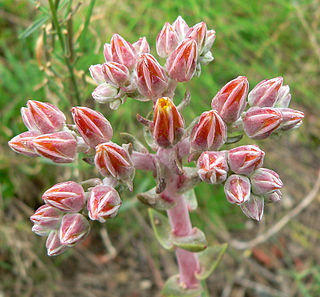
Dudleya palmeri is a species of succulent plant in the family Crassulaceae known by the common name Palmer's liveforever. This Dudleya is endemic to California where it grows along the coast. It is characterized by orange to red over yellow or pink flowers. It is a polyploid species that closely resembles Dudleya lanceolata but has a coastal habit, and hybridizes with Dudleya caespitosa and Dudleya cymosa.

The Hyrcanian forests are a zone of lush lowland and montane forests covering about 55,000 square kilometres (21,000 sq mi) near the shores of the Caspian Sea in Iran and Azerbaijan. The forest is named after the ancient region of Hyrcania. The World Wide Fund for Nature refers to the ecoregion as the Caspian Hyrcanian mixed forests. Since 5 July 2019, the Hyrcanian Forests have been designated a UNESCO World Heritage Site. In September 2023, the heritage site expanded to incorporate portions of the forest located in Azerbaijan.

Eupatorium japonicum, known as fragrant eupatorium in English and 白头婆 bai tou po, in Chinese, is a herbaceous plant species in the family Asteraceae. It is native to China, Japan and Korea.
Barbieria is a genus of flowering plants in the legume family, Fabaceae. It contains a single species, Barbieria pinnata, a climber native to the tropical Americas, from southern Mexico through Central America and the Caribbean to northern South America.
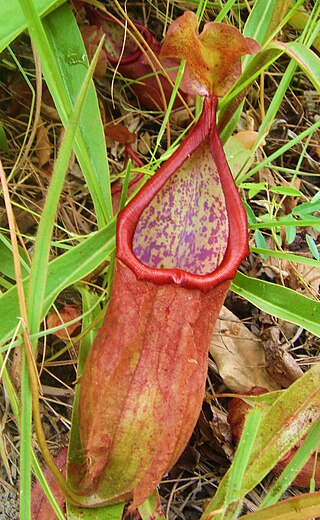
Nepenthes suratensis is a tropical pitcher plant endemic to Surat Thani Province, Thailand, where it grows near sea level in coastal savannah and grassland. It is thought to be most closely related to N. andamana.
Adenorandia is a monotypic genus of flowering plants in the family Rubiaceae. It was described by Vermoesen in 1922. The genus contains only one species, viz. Adenorandia kalbreyeri, which is found from west-central tropical Africa.

Searsia chirindensis is a medium-sized, semi-deciduous, trifoliate Southern African dioecious tree of up to 10 m tall, rarely 20 m, often multi-stemmed, occurring along the coastal belt from the Cape, through KwaZulu/Natal, Eswatini, Zimbabwe and Mozambique as far north as Tanzania, and growing in a wide variety of habitats such as open woodlands, in forests, along forest margins, in the open, among rocks and on mountain slopes. It was named by Swynnerton from a specimen collected by him near the Chirinda Forest in the Chipinge District of Southern Rhodesia. This is one of more than a hundred southern African species in the genus. It is commonly known as red currant because of a fancied resemblance of the fruit to that of the European redcurrant.
Branches dull brown or blackish, cylindric, pubescent or glabrous. Petiole 1·5–6·5 cm. long, almost cylindric, narrowly canaliculate and marginate above, pubescent or glabrous. Leaflets ± dull red-brown, ovate or ovate-lanceolate, acuminate, entire and ± undulate at the margin, membranous to ± rigid or subcoriaceous, glabrous or ± pubescent on the margin, midrib and nerves; median leaflet (3)6–13(16) × (1·2)2·5–4(7) cm., cuneate and frequently petiolulate at the base, the lateral ones (2)2·5–7(12) × (0·8)1·3–3·5(5·5) cm., asymmetric and slightly cuneate or somewhat rounded at the base, very shortly petiolulate to sessile; midrib slightly raised in the upper surface, very prominent below; lateral nerves arcuate, slender, raised on both sides, reticulation lax, almost invisible or sometimes conspicuous. Panicles terminal and axillary, ample, pyramidal, much branched, multiflorous, the terminal ones longer than the leaves, the axillary ones as long as the latter or somewhat longer; pedicels 1–2·5 mm. long. Male flowers: calyx-segments 0·5 mm. long, ovate, obtuse, glabrous; petals c. 1·5 mm. long, elliptic, obtuse; filaments c. 1 mm. long. Female flowers: ovary ovoid; styles reflexed; disk cupuliform, 5-lobulate; staminodes present. Drupe pinkish-yellow to reddish-brown, shining, (4)5(6) mm. in diam., globose, glabrous.
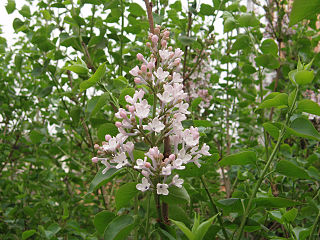
Syringa oblata is a species in the genus Syringa, in the family Oleaceae. It is also known as early blooming lilac or broadleaf lilac.
Syringa pinetorum is a species in the genus Syringa, in the family Oleaceae.
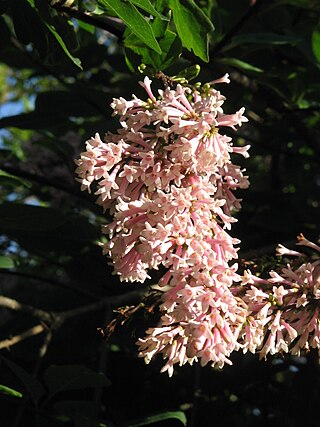
Syringa tomentella is a species in the genus Syringa, in the family Oleaceae.

Brachylaena rotundata is an occasionally deciduous Southern African shrub or small tree growing to some 8m in height and of the family Asteraceae. It occurs in eastern Botswana, Transvaal, Mozambique, Zambia and Zimbabwe, growing in open woodland, on rocky koppies and slopes, and on stream banks. Kew accepts Brachylaena rotundata S. Moore as a species while 'Flora of Mozambique' treats it as a variety of Brachylaena discolor DC. It bears attractive foliage, green on the upper surface and silver-grey on the lower, leaves turning slightly reddish in autumn.
Leaves with petioles from 2 mm to 7 mm. long, lamina 4–15 x 2.5–6 cm., larger on coppice shoots, broadly oblanceolate or elliptic, obtuse to rounded at the apex, cuneate or rounded base, entire, occasionally coarsely dentate near the apex; upper surface araneous when young, or glabrescent; lower surface greyish tomentellous with prominent veins. Capitula sometimes preceding the leaves, young synflorescences with buds in axillary and terminal spikes, mature synflorescences with numerous capitula in dense terminal panicles 4–40 cm. long, or in short raceme-like panicles in axils of old leaves. Involucres cyathiform to obconic. Phyllaries minutely glandular outside, subobtuse, margins ciliolate, the outer phyllaries from c. 1 mm. long and ovate, the inner to c. 5 mm. long becoming lorate-lanceolate, narrowly obtuse or blunt at the apex; the outermost 5–8 series decreasing in size and extending down to the base of the capitulum stalk. Male flowers: corollas dull-yellow, 3–5 mm. long, lobes c. 1.5 mm. long and ± recurved; pappus uniseriate, setae 3–4 mm. long, subplumose, the seta barbs exceeding the seta axis in width. Female flowers: corollas dull-yellow, 3–5 mm. long, filiform, lobes erect up to c. 0.5 mm. long; achenes c. 4 mm. long, subcylindric-fusiform, narrowly c. 8-ribbed, pubescent; pappus 2-several-seriate, setae 4–5 mm. long, ± terete or flattened, seta barbs ± equalling the seta axis in width.""
Hypericum acmosepalum is a dwarf shrub in Hypericumsect. Ascyreia that is native to China and known as jian e jin si tao locally.

Prunus himalayana, called jyokun shin in Tibetan and 喜马拉雅臭樱 in Chinese, is a species of Prunus native to Nepal, Bhutan, Sikkim and Tibet. It prefers to grow 2,800 to 4,200 m above sea level in the Himalayas. As Maddenia himalaica it was the type species for the now unrecognized genus Maddenia.
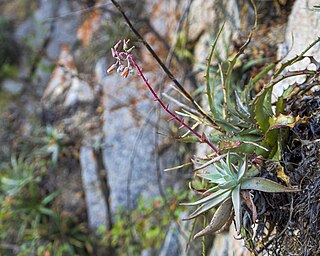
Dudleya nubigena is a species of succulent plants in the family Crassulaceae. It is a rosette forming perennial with flattish leaves. Endemic to southern Baja California Sur, the species is found in the Sierra de la Laguna and the surrounding lowlands, a small southern portion of the Sierra de la Giganta, and on Isla Espíritu Santo, with a subspecies endemic to Cerralvo Island.

Dudleya cymosasubsp. cymosa is a species of succulent perennial plant in the family Crassulaceae native to California. It is the autonymous subspecies for Dudleya cymosa, and is known by the common name canyon liveforever. It is native to the California Coast Ranges, the Sierra Nevada and the Santa Monica Mountains. It is characterized by bright-yellow, orange or red flowers and broad, wide leaves. This plant is commonly found growing on rocky outcrops, talus slopes, and in shaded canyons.
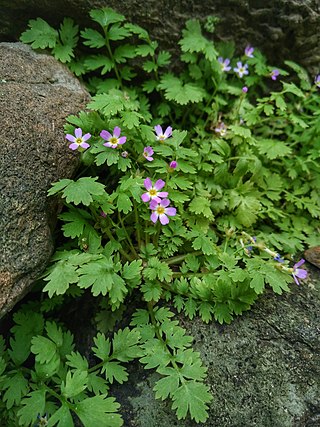
Primula cicutariifolia, is a species of flowering plant within the genus Primula and family Primulaceae.














